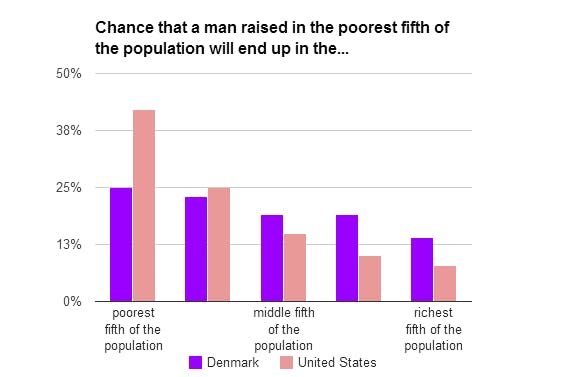Can Chicago hit 30 miles of green lanes before the snow flies?
By: Michael Andersen, Green Lane Project staff writer

We don’t have to dream of a country where protected bike lanes and other quality bike infrastructure have dramatically improved life for people in poverty. We can visit it.
It’s called Denmark, and it’s arguably the most egalitarian country in the world.
Data published online for the first time suggests that bicycle transportation has been part of that triumph. Not the biggest part, but a very real one.
After embracing cars in the 1950s and 60s, Denmark took a U-turn around 1970 and began using protected bike lanes and low-speed side streets to make bicycle transportation an efficient, comfortable option. Today, this small, prosperous peninsula (whose capital, Copenhagen, is about the size of Columbus, Ohio) has the second-highest biking rates in the developed world after the Netherlands.
Ask Danes what sort of Danish people bike and they will probably say: “everyone.” In a sense, that’s true. But it also obscures something you’ll almost never hear a Dane mention: the massive benefit biking provides to the country’s poorest.
Yes, people of all incomes bike in Denmark. But biking delivers its biggest advantages to the neediest Danes.
Who are these very low-income Danes? Some are students living on state grants of about $11,000 a year. Others are recent immigrants and the long-term unemployed, who don’t fully qualify for the cash payments Denmark offers to people in school or between jobs. Because bikes are everywhere in modern Denmark, these poor people can remain mobile in Danish cities without facing pressure to devote a huge share of their money to cars if they don’t want to.
Adding protected lanes to major streets made bike trips as safe and comfortable as car trips
Here’s the complete breakdown (previously unavailable online) of how Danes of different incomes get around:
And here’s the same breakdown in the United States:
For the poorest Danes, car transportation is expensive. But it isn’t impossible. It’s not even rare.
It’s simply optional.
Only 41 percent of the poorest Danes’ trips happen in cars, compared to 72 percent of trips by the poorest Americans. More than anything else, this difference is because of bicycles: quick, cheap, direct and easily combined with good public transit.
Though Danes bike more, they don’t walk less or ride transit less. Danes at almost every income level do both of those things more than their American peers. Essentially all of Denmark’s additional biking is due to one thing: less reliance on cars.
Denmark has made it dramatically easier for poor people to escape poverty
In most of the United States, not owning a reliable car can turn poverty into an inescapable trap.
For someone without a working car, a huge share of jobs essentially drop out of reach. For 73 percent of Americans, the typical job would take more than 90 minutes to reach by public transit. Living carless in most American cities can mean being cut off from many of the family and friends who help people find work, feel happy, care for children, or recover from emotional or economic bad fortune. This problem shackles both the poorest American adults and their kids.
It’s part of the reason that only a third of children born into the poorest American families ever make it to the economic middle or above. Four in ten spend their lives in the lowest fifth.
In Denmark, things are different. As the chart above shows, three-quarters of Denmark’s poorest improve their situation by middle age. About one in seven of Denmark’s poorest children lands among the country’s richest adults, almost twice the rate in the United States.
Denmark is different from the United States in many ways; biking is just one. Bicycling is certainly less important to Danish equality than tax and social security policy.
Moreover, Denmark has not eliminated poverty.
But it’s done the next best thing: it’s made poverty much easier to escape. And one of its many tools in that fight has been making it normal and comfortable to do the daily business of one’s life on a bicycle.
